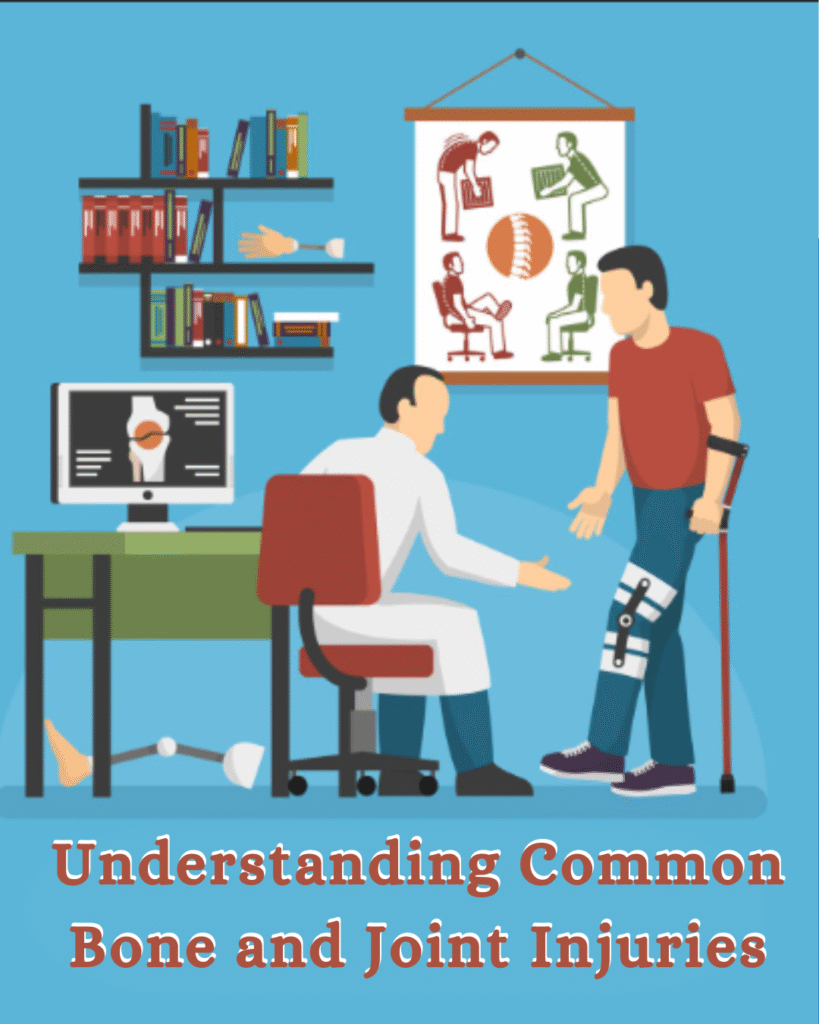Bone and joint injuries are more common than we think — and they can affect anyone, from young athletes to elderly individuals. Whether it’s a sudden fall, repetitive strain, or age-related wear and tear, musculoskeletal injuries can impact your mobility and quality of life.
In this blog, we’ll break down the most common bone and joint injuries, their symptoms, causes, treatment options, and most importantly, when to consult an orthopedic doctor.
Common Bone Injuries
1. Fractures (Broken Bones)
A fracture is a break or crack in the bone, usually caused by trauma, falls, or accidents. Fractures can be:
-
Simple (clean break)
-
Compound (bone pierces the skin)
-
Stress (small cracks due to overuse)
Symptoms:
-
Intense pain
-
Swelling
-
Bruising
-
Inability to move or bear weight
2. Dislocations
This occurs when a bone slips out of its joint. Dislocations often affect the shoulder, fingers, elbows, or knees and are usually caused by sports injuries or falls.
Symptoms:
-
Visible deformity
-
Swelling
-
Severe pain
-
Inability to move the joint
Dislocations are a medical emergency. Visit an orthopedic specialist immediately.
Common Joint Injuries
3. Ligament Injuries (Sprains)
A sprain is the stretching or tearing of ligaments — tough tissues that connect bones in a joint. They commonly affect the ankle, wrist, and knee.
Causes:
-
Sudden twists
-
Falls
-
Sports-related movement
Symptoms:
-
Swelling
-
Pain
-
Limited range of motion
4. Tendonitis
This is the inflammation of tendons — tissues that connect muscles to bones. Tendonitis is often caused by overuse and repetitive movements.
Common types:
-
Tennis elbow
-
Golfer’s elbow
-
Achilles tendonitis
Symptoms:
-
Dull ache or sharp pain
-
Swelling
-
Tenderness near a joint
5. Bursitis
Bursitis is the inflammation of the small, fluid-filled sacs (bursae) that cushion the bones, tendons, and muscles around joints.
Common areas:
-
Shoulders
-
Elbows
-
Hips
Symptoms:
-
Joint stiffness
-
Swelling
-
Pain during movement
Who’s at Risk?
Anyone can suffer from bone and joint injuries, but certain factors increase the risk:
-
Age (especially over 50)
-
High-impact sports
-
Poor posture
-
Sedentary lifestyle
-
Osteoporosis or arthritis
-
Overuse or repetitive motion
When Should You See an Orthopedic Doctor?
While minor aches can be managed at home, you should visit an orthopedic specialist near you if:
-
Pain or swelling persists beyond a few days
-
Joint appears deformed or unstable
-
There’s a sudden loss of mobility
-
You hear a pop at the time of injury
-
Pain worsens with activity
-
You’re unable to bear weight or move the limb
-
You’ve had repeated injuries in the same area
An orthopedic consultation can help diagnose the issue through X-rays, MRIs, or physical examination, and guide you on treatment — whether it’s physical therapy, medication, or surgery.
✅ Tip: Early diagnosis can prevent long-term damage and reduce the risk of chronic joint problems.
Recovery and Prevention
Here are general tips to support bone and joint health:
-
Warm-up before exercise
-
Use proper techniques during workouts
-
Maintain a healthy diet rich in calcium and vitamin D
-
Avoid overuse and repetitive strain
-
Listen to your body and rest when needed
Final Thoughts
Understanding common bone and joint injuries helps you take quick action and seek timely care. Ignoring pain or pushing through an injury can worsen the condition. Whether it’s a fracture, ligament tear, or joint inflammation, early treatment is key to a full recovery.
If you or your loved one is experiencing persistent joint pain, swelling, or movement restriction, don’t delay. Consult our orthopedic specialist Dr. Umesh Jadhav in Nigdi, PCMC to get a proper diagnosis and start your journey to recovery.
Need Expert Orthopedic Care?
If you’re looking for a trusted orthopedic doctor in your area, book a consultation today. Your bones and joints deserve expert care to keep you moving pain-free!

